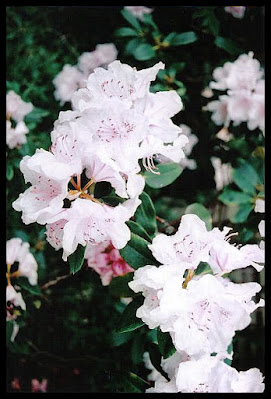During the summer months some private gardens are open for charity and I visited this lovely mature garden one day in May 2011. I thought it was worth including on my former website as it reflects some of the difference between the South-West peninsular and other parts of Britain, and now also posting it on my blog gives me the opportunity to add more to it.
As seen in these first two photos there are several tropical palms, as well as other unusual plants and trees. Although not indigenous to Britain, palms thrive well here in the South-West because of its temperate climate and, due to those intrepid Victorian (and earlier) travellers bringing back seeds and plants, they have now become a traditional part of our town and coastal scapes in Devon and Cornwall.
A large garden, there are several paths taking the visitor through the flower beds to separate lawned spaces.
It's such a delight to walk amongst the different varieties of mature trees, and other lovely plants...especially when, like me, your only garden is a rather small balcony overcrowded with planters and flowerpots!
The lovely Rhododendron isn't native to Britain; the species of rhododendrons originate from the range between Southeast Asia to Malaysia, Indonesia, the Philippines & New Guinea. Now found all over the world, they are one of the plants that have become naturalised and can have a detrimental effect on native plants. Garden 'escapees' can be found in woodlands, in which they thrive, and where they have overshadowed and killed off ground-loving plants. They are especially considered a nuisance on some South West cliffs, especially in Cornwall, where work parties have been grubbing up as much as possible in order to save the flora and habitats of fauna on clifftops.
The flowers are beautiful and very showy though, and are still a delight to see in gardens such as this.
The house (below) built circa 1930, softened by firs and other trees.
Below is a tree which I'd read about but not actually seen before in real life. Cercis Siliquastrum, also known as the Judas Tree, is a bushy, deciduous small tree from the eastern Mediterranean. Also known by the name Love Tree, it has heart-shaped leaves with clusters of bright pink, pea-shaped flowers in the Spring. Its commonest name of Judas Tree is thought to be because it was the tree from which Judas Escariot hanged himself - which doesn't make any sense because of its thin-branched and fragile nature. However, the French name for it is Arbre de Judee, meaning tree of Judea, which makes a lot more sense because Judea is the area where it used to be common.
Below is a tall and twisty Eucaliptus tree, with its delightful silver-grey bark and bluish grey-green leaves. Indigenous to Australasia, it has a great many properties, mostly well-known for Eucalyptus Oil, which is used for cleaning, as a solvent, and for antiseptics, mosquito repellents, in deodorants and toothpaste.
I was quite surprised when researching to find its more unusual uses. Used as a dye for silk and wool, the colours range from yellow and orange to tan, green, a deep rust red and chocolate brown. Also the wood is used for the making of didgeridoos, the traditional Aboriginal wind instruments. Most surprising of all is their ability for prospecting...
"Prospecting.
Eucalyptus trees in the Australian outback draw up gold from tens of metres underground through their root system and deposit it as particles in their leaves and branches. A Maia detector for x-ray elemental imaging at the Australian Synchrotron clearly showed deposits of gold and other metals in the structure of eucalyptus leaves from the Kalgoorlie region of Western Australia that would have been untraceable using other methods. The microscopic leaf-bound "nuggets" are not worth collecting themselves, but may provide an environmentally benign way of locating subsurface mineral deposits."
Taken from Wikipedia
And of course, they are also the main food source for several marsupials, including Koalas and some possums.
Altogether a very pleasant afternoon spent strolling around and finding the odd hidden corner full of a huge variety of shrubs and flowers...
...and this lovely black cat, intent on watching something in the undergrowth.
The Millenium Bells, below, didn't come out very clearly on the photo so I softened it up even more to accentuate their snowy white glow.
As well as the garden to enjoy, tables and chairs were set out on the front lawn, along with a stall selling cakes and beverages. Jars of homemade jams and pickles were also on sale so I bought some plum jam...my favourite! I also enjoyed some homemade cake with a cup of coffee and sat at one of the tables, where I was joined by a couple I know, and had a really nice time chatting in the sunshine.
Below, a 'secret garden' kind of entrance from the lane, which can't be seen unless you know what to look for and are prepared to slalom your way between heavily planted bushes.
And finally, I recently took some more photos when walking past the main entrance with gorgeous gates, which I hadn't noticed on the original visit.






















No comments:
Post a Comment